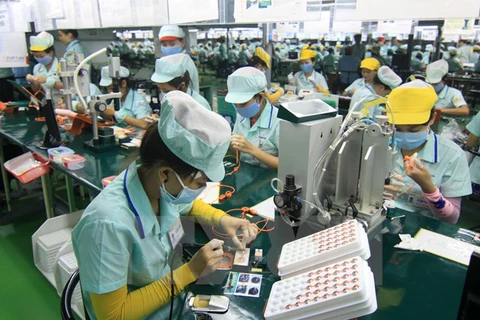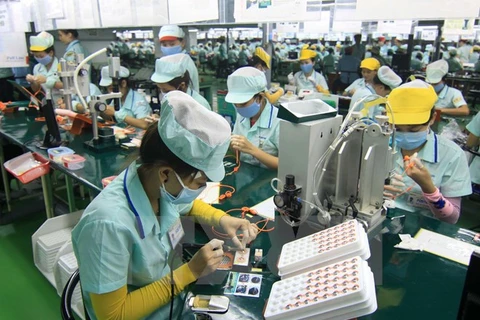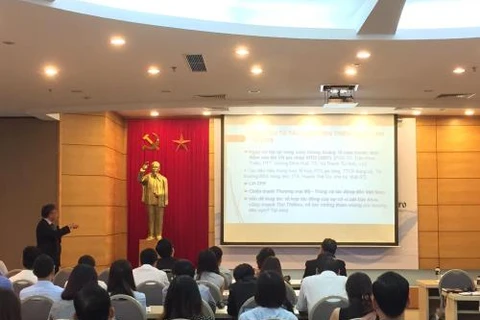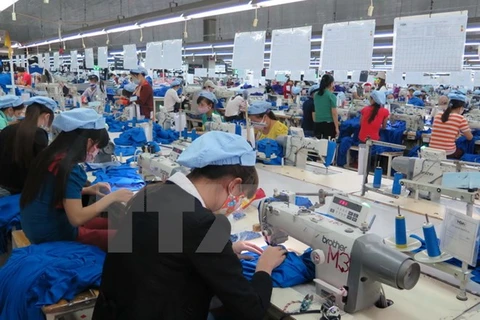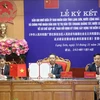Hanoi (VNA) – Vietnam’s export turnover is likely to reach 236.6 billion USD in 2018, an increase of 10 percent against the previous year, amid favourable domestic and foreign economic conditions, say analysts.
The first half of this year ended with positive export outcomes, creating a good momentum for the country to enjoy trade surplus for the rest of the year, they said, adding that more orders in the remaining quarters of the year will give a boost to exports.
According to Tran Thanh Hai, deputy head of the Import-Export Department under the Ministry of Industry and Trade (MoIT), Vietnam earned 113.93 billion USD from exports in the first six months of 2018, up 16 percent year-on-year.
Of the sum, more than 33.1 billion USD came from the shipment of domestic enterprises, an annual rise of 19.9 percent, while the remaining came from the foreign invested sector (including crude oil), up 14.5 percent.
As many as 20 key sectors enjoyed an export turnover of over 1 billion USD, including five in the agro-fisheries sector, Hai said.
Notably, it was the sectors of telephones and spare parts; computers; electronic products and components; garments; machinery; and footwear that continued to be the leading foreign currency earners.
He added that the export structure is continuing to shift in a positive direction in line with the roadmap for the implementation of the commodity import-export development strategy for 2011-2020 with orientation towards 2030.
However, the export of raw products and mineral industries has gradually declined, accounting for only 1.9 percent of total export value, compared to the 2.5 percent recorded in the same period last year.
Meanwhile, the proportions of the processing and manufacturing industries and agro-fisheries sector have been improving, hitting 11.8 percent and 81.9 percent respectively, compared to 12.5 percent and 80.2 percent in 2017.
Hai said that recently, Vietnam has made good use of tariff preferences in signed free trade agreements (FTA) to expand its export market. This was reflected through the country’s export turnover increasing 9.2 percent to the US, 12.3 percent to the EU, 28 percent to China, 31.8 percent to the Republic of Korea, and 17.4 percent to ASEAN.
In particular, Vietnam saw impressive export growth in several markets such as India (96.6 percent), Iraq (27.9 percent), Ukraine (22.4 percent), and Russia (25.4 percent).
Hai further said that the country’s import value reached 111.22 billion USD in the first half of the year, representing a year-on-year rise of 10 percent.
Of the figure, 46 billion USD was spent by domestic businesses, an increase of 12.9 percent, while the remaining by foreign enterprises, up 8.1 percent.
Notably, the country enjoyed a trade surplus of about 2.7 billion USD in the period, accounting for nearly 2.4 percent of total export revenue.
The foreign direct investment (FDI) sector’s trade surplus reached 15.7 billion USD (excluding crude oil) while domestic business ran a trade deficit of 12.9 billion USD.
According to trade experts, these outcomes indicated that tensions in trade ties among nations and the risk of a global trade war in the first months of this year did not have a significant impact on Vietnam’s export.
Duong Duy Hung, head of the MoIT’s Planning Department, attributed the results to business climate improvements, renovations in supporting startups, and increasing registered foreign investment.
Together with benefiting from the signed FTAs, Vietnam sees great prospects for export growth in the time to come as many key products, especially in the processing industry, have received orders by the end of third quarter and for the remainder of the year, he said.
However, Hung also pointed out barriers to Vietnam’s export business as increasing protectionism around the world is placing industrial products at risk of facing trade defence measures.
In addition, many agricultural products and minerals are unlikely to have higher growth in export volume, while some others fail to tap their full processing capacity due to a lack of materials, he added.
In the remaining months of the year, Hung said the MoIT will persistently implement measures to remove difficulties for production, create supplies for export, and expand export markets.
It will continue focusing on improving the efficiency of coordination mechanisms among ministries, agencies, localities, associations, and businesses to create more synchronous connections in dealing with problems arising in international trade, he stated.
Together with making basic changes in trade promotion work, the MoIT will boost institutional reform, perfect the legal framework, renovate the State’s management and organisation of apparatus, and improve the investment and business environment in order to mobilise resources for production.
Hung also emphasised the need to provide high-quality materials for production, increase the added value of goods, and create products that meet both local quality and food safety standards, as well as the requirements of import markets.
The ministry will continue to research, forecast, and offer warnings of trade defence measures applied to Vietnam’s exports, and take concrete, resolute measures to clear obstacles for businesses, helping them boost production, exports, and market development.
It will seek possibilities to expand new potential export markets while consolidating and increasing market shares in traditional markets, especially those of FTA partners, together with implementing international integration commitments, he noted. -VNA
The first half of this year ended with positive export outcomes, creating a good momentum for the country to enjoy trade surplus for the rest of the year, they said, adding that more orders in the remaining quarters of the year will give a boost to exports.
According to Tran Thanh Hai, deputy head of the Import-Export Department under the Ministry of Industry and Trade (MoIT), Vietnam earned 113.93 billion USD from exports in the first six months of 2018, up 16 percent year-on-year.
Of the sum, more than 33.1 billion USD came from the shipment of domestic enterprises, an annual rise of 19.9 percent, while the remaining came from the foreign invested sector (including crude oil), up 14.5 percent.
As many as 20 key sectors enjoyed an export turnover of over 1 billion USD, including five in the agro-fisheries sector, Hai said.
Notably, it was the sectors of telephones and spare parts; computers; electronic products and components; garments; machinery; and footwear that continued to be the leading foreign currency earners.
He added that the export structure is continuing to shift in a positive direction in line with the roadmap for the implementation of the commodity import-export development strategy for 2011-2020 with orientation towards 2030.
However, the export of raw products and mineral industries has gradually declined, accounting for only 1.9 percent of total export value, compared to the 2.5 percent recorded in the same period last year.
Meanwhile, the proportions of the processing and manufacturing industries and agro-fisheries sector have been improving, hitting 11.8 percent and 81.9 percent respectively, compared to 12.5 percent and 80.2 percent in 2017.
Hai said that recently, Vietnam has made good use of tariff preferences in signed free trade agreements (FTA) to expand its export market. This was reflected through the country’s export turnover increasing 9.2 percent to the US, 12.3 percent to the EU, 28 percent to China, 31.8 percent to the Republic of Korea, and 17.4 percent to ASEAN.
In particular, Vietnam saw impressive export growth in several markets such as India (96.6 percent), Iraq (27.9 percent), Ukraine (22.4 percent), and Russia (25.4 percent).
Hai further said that the country’s import value reached 111.22 billion USD in the first half of the year, representing a year-on-year rise of 10 percent.
Of the figure, 46 billion USD was spent by domestic businesses, an increase of 12.9 percent, while the remaining by foreign enterprises, up 8.1 percent.
Notably, the country enjoyed a trade surplus of about 2.7 billion USD in the period, accounting for nearly 2.4 percent of total export revenue.
The foreign direct investment (FDI) sector’s trade surplus reached 15.7 billion USD (excluding crude oil) while domestic business ran a trade deficit of 12.9 billion USD.
According to trade experts, these outcomes indicated that tensions in trade ties among nations and the risk of a global trade war in the first months of this year did not have a significant impact on Vietnam’s export.
Duong Duy Hung, head of the MoIT’s Planning Department, attributed the results to business climate improvements, renovations in supporting startups, and increasing registered foreign investment.
Together with benefiting from the signed FTAs, Vietnam sees great prospects for export growth in the time to come as many key products, especially in the processing industry, have received orders by the end of third quarter and for the remainder of the year, he said.
However, Hung also pointed out barriers to Vietnam’s export business as increasing protectionism around the world is placing industrial products at risk of facing trade defence measures.
In addition, many agricultural products and minerals are unlikely to have higher growth in export volume, while some others fail to tap their full processing capacity due to a lack of materials, he added.
In the remaining months of the year, Hung said the MoIT will persistently implement measures to remove difficulties for production, create supplies for export, and expand export markets.
It will continue focusing on improving the efficiency of coordination mechanisms among ministries, agencies, localities, associations, and businesses to create more synchronous connections in dealing with problems arising in international trade, he stated.
Together with making basic changes in trade promotion work, the MoIT will boost institutional reform, perfect the legal framework, renovate the State’s management and organisation of apparatus, and improve the investment and business environment in order to mobilise resources for production.
Hung also emphasised the need to provide high-quality materials for production, increase the added value of goods, and create products that meet both local quality and food safety standards, as well as the requirements of import markets.
The ministry will continue to research, forecast, and offer warnings of trade defence measures applied to Vietnam’s exports, and take concrete, resolute measures to clear obstacles for businesses, helping them boost production, exports, and market development.
It will seek possibilities to expand new potential export markets while consolidating and increasing market shares in traditional markets, especially those of FTA partners, together with implementing international integration commitments, he noted. -VNA
VNA

